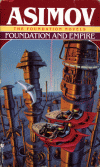If I remember correctly, I saw Contact (the movie) in the theater when it came out. I enjoyed it and always wondered how it compared to the book. It turned out that my future wife owned the book, but I didn’t get around reading it until now. Of course movies rarely ever measure up to the novels they are based on, and this was no exception. Don’t get me wrong, the movie was good, however it just scratched upon the surface of what the novel contains.
The main character, Ellie, is a radio astronomer that eventually becomes part of the Search for Extraterrestrial Intelligence (SETI). One night the project stumbles upon an unmistakably non-random signal. Initially, it just seems to be that the signal is just a repeating list of prime numbers. Upon closer inspection, scientists uncover many layers to the signal by calculating wave modulation and other ways that I don’t remember. Anyway, the movie skips over many of the steps leading up to the discovery that the message really contains instructions to make something.
One of the more interesting themes is the selfishness of the U.S. government. The officials are worried that other countries might gain some type of military advantage if they build this “Machine” first. The scientists already determined early one that decoding the message was impossible without worldwide cooperation due to the origin of the signal and rotation of the Earth. The government hesitantly cooperated with the “Machine Counsel” in piecing the message together, but they wanted to keep the nature of the message secret as long as possible.
One interesting thing to me about reading Science Fiction is how often new ideas become a reality. In this story, a man named Sol Hadden developed a technology called Adnix. This chip would mute the sound on the TV when commercials appeared. It detected the increase in volume that many advertisers built into their ads. This book came out in 1985, and I’ve looked around to see if such a thing was in use back then, but haven’t been able to. I know for a fact that today there are software programs that can detect and automatically remove commercials from recorded TV. Sagan might not have been the first person to think of this, but he was definitely ahead of his time.
I thoroughly enjoyed Contact, and don’t think that the book was spoiled for me by seeing the movie first. Carl Sagan did a good job of walking me through all sorts of mathematical and scientific concepts some of which include black holes, relativity, number theory, pattern recognition, and cryptography. He also eloquently addresses some of the economic, political, religious ramifications of the worldwide goal to make the Machine. Sagan is an excellent writer, and I look forward to reading more of his work in the future.



Watching Contact in theater as a teen was a serendipitous discovery of one of my favorite movies still to this day. It instilled a sense of lingering wonder that still has the potential to stir me me deeply (especially the beach scene).
One day I was browsing a used bookstore and saw the book. Nervous that it could disturb my feel for the story and the movie, I bought it any way and started reading. I couldn’t put it down and was so surprised to see all the differences from the movie. The book is highly enjoyable, definitely a recommended read and I am glad I have a “preloved” copy in my book collection. I am also pleased that the film was more of an adaptation than simply revised version of the book as it made the film unique and, to me anyway, still complimentary to the book.